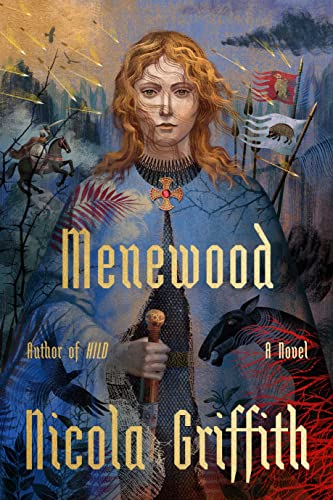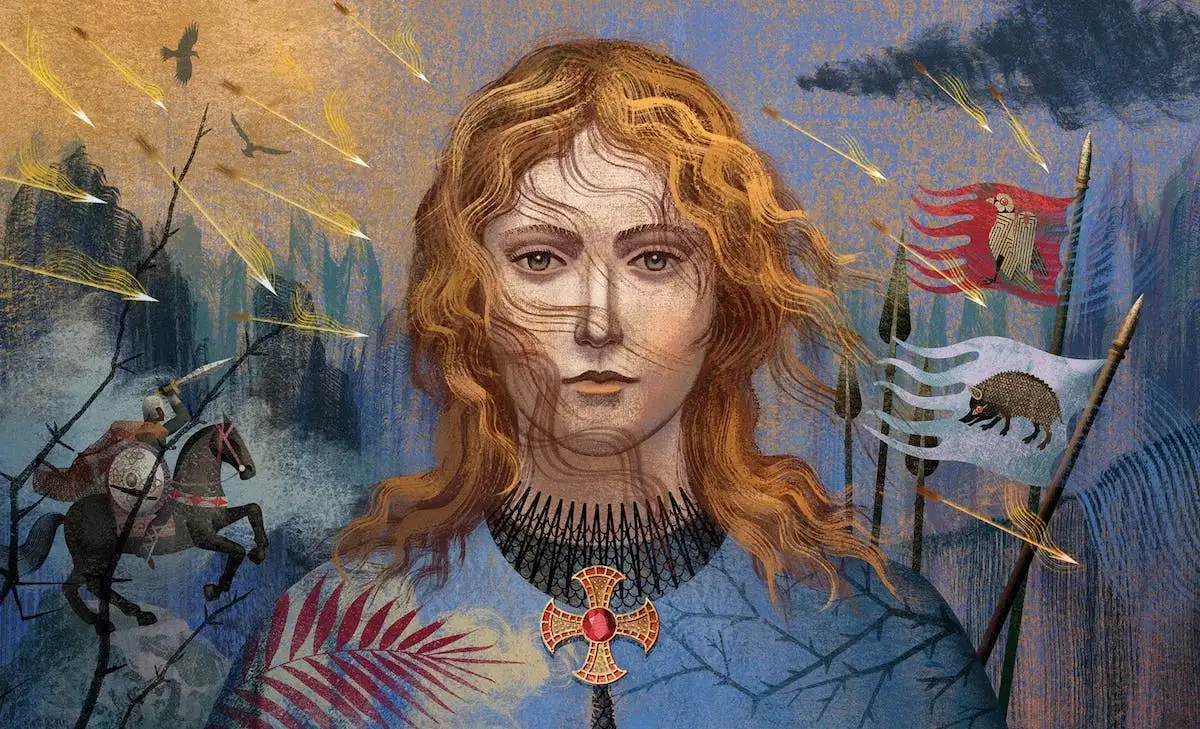When Nicola Griffith’s Nebula-nominated novel Hild came out in 2013, it became an instant classic of feminist speculative fiction. The novel introduced the 7th century British prodigy Hild, who in real life would go on to become St. Hilda of Whitby, the medieval abbess who famously advised kings and princes. However, in exploring the years of Hilda’s life that are lost to history, Griffith made Hild her own.
In Hild, Hild was a seer and godmouth to King Edwin of Northumbria. Now, in Menewood, book 2 of The Hild Sequence, Hild has carved out a life for herself in the titular hidden enclave. However, the kingdoms of Britain are growing hostile, war is roiling on the horizon, and Hild knows it’s only a matter of time before violence finds its way back to her.

Menewood, like its predecessor, is a rich tapestry of history, mysticism, and adventure. As Hild deftly navigates conflict at the thrones of testy kings and in the bloody chaos of the battlefield, she also fights to protect the people she loves, leading her to both victory and heartrending loss.
With Menewood hitting bookstores this week after a ten-year wait, The Mary Sue sat down with Griffith to talk about Hild’s new adventure. In addition to Hild, Griffith is the Nebula- and Lambda-winning author of Spear, Ammonite, So Lucky, and Slow River, and the founder of #CripLit, an online community for disabled writers.
This interview was edited for length and clarity.
When Menewood begins, a few years have passed, and Hild is a little older. How did you go about telling the next chapter of her story?
I had originally imagined these books as a trilogy. I thought the first book would cover 17, 18 years of her life. The next book would cover maybe 15 years of her life. I “knew” where the second book had to end, which was Hild at age 33, about to get on a boat to France, and then being recruited into the church and immediately going north. But as soon as I started, it became clear that that book would be at least a million words. Obviously I could have done it, but it would not have been the book I wanted to write. I wanted to write a book of the kind where the reader would really believe that this woman was able to change her world.
To make that believable, you have to show the story’s heft and depth. You can’t just say, “and then three years passed and she had learned how to do blah, blah, blah, blah.” Or, “she led the army and they slaughtered everybody.” You have to show her learning it.
What were some of your favorite parts of building up Hild’s world? There are so many details, from beekeeping to dying cloth to engaging in warfare.
I did a lot of fun research. [For example,] how would you make parchment and inks? In fact, I left 80% of that on the cutting room floor, because nobody actually wants that much detail. I just loved living through and with Hild. I loved being inside her and walking through the world, and seeing things through her eyes and smelling things and touching things. I’ve been researching this era constantly now for 20 years, and I follow my nose down all kinds of rabbit holes. Suddenly I found myself learning a lot about foxes just for one little scene.
Tell me more about Menewood itself, since it’s important enough that it’s used as the title of the novel.
Well, it’s a real place, very close to where I grew up. There’s a big park there now, and as a kid, I used to run wild in that park, so it was a place that was really close to my heart. Where I originally started Hild was in Caer Loid, which is actually where Kirkstall Abbey is now. I spent a lot of time there, and I just wanted Hild to have a place that was my place. Menewood Park was a home away from home in a particular way, and in the novel, it needed to be a place that could be hidden and kept secret. So I did the research and found that it would’ve been kind of soggy there, and boggy and wooded, and there would be ways to keep it out of sight.
Do you feel like it took a lot of imagination to take that park where you played as a kid, and shift it back hundreds of years to Hild’s time?
Well, I’ve been doing it all my life, because I’ve been in love with history all my life. The thing about living in Yorkshire is that you are surrounded by history. You look at the horizon and either there’s a ruined castle or a standing stone, or what you think is a hill is actually a barrow. As a kid, I was always scrambling over things and thinking, wow, I wonder what it was like back then. Part of me has always walked through a double world that way. So on the one hand I could say, yeah, [imagining Hild’s Menewood] was no effort at all. And on the other I could say, well, yes, it was, it’s taken me 60 years, because I’ve been doing it all my life.
What were the challenges of fleshing out Hild herself? What was especially enjoyable about making up a backstory for this historical figure?
I was intrigued when I read Bede’s Ecclesiastical History of the English People, because he talks about very few women, and those he approves of he calls virgins. Whether or not they were [literally virgins], they were holy virgins, and that’s because that’s what good women were to him. But Hild was regarded so highly that kings and princes took her advice. She trained five bishops! I mean, Bede thought Hild was the bee’s knees, but he doesn’t call her a virgin, and then he leaves out this huge chunk of her life. We meet her when she’s 13, and then we don’t see her again until she’s 33 and just about to join the church. Everything else is missing. What was it that Bede didn’t approve of?
There are two aspects to Hild’s character that seem almost contradictory. There’s her reputation as a warrior, the Cath Llew [lynx] and the Butcherbird. But then she has this fierce and deep love of working the land and seeing her people prospering. How did you develop these two sides of her character?
Oh, I think they’re intimately entwined. I think they are two faces of the same coin. Hild loves life. She loves the life of the land. She loves the life of the people around her. She loves the living community of the world. And she wants to defend what she loves. That means building and growing and protecting and working the land and the community. Obviously leading an army and killing people is pretty different to planting cabbage, but you have to understand how things connect in the same way.
You need the same kind of mind, I think, to build. If you want to feed a community, you have to understand weather, geography, and geology. You need to know how and when things will grow. Those are the same skills that you need for war. I’m not talking about being the grunt on the ground, the soldier who takes orders. Hild’s role is much more like the farmer, in a way, figuring out how things connect and what the weather is going to be like, and how that will affect the killing or harvesting, or the planting or recruiting. It’s the same set of skills, just focused differently.
That reminds me of one aspect of Hild’s character: her gift is that she sees things that others miss. She gains a reputation as a seer simply because she notices things that slip past other people. What was it like to create a character who’s smarter than the reader? Because I felt like she was smarter than me.
Yeah, she’s smarter than me, too! Because she’s very rarely wrong, and when she is wrong, it’s kind of spectacular. It’s tempting to say she’s a bit Mary Sue-ish, right? It would be nice to be tall and smart and well-respected and feared.
But in terms of noticing, I couldn’t have written this book if I didn’t have multiple sclerosis, because how I approached writing really began to change as I gradually lost my mobility. I’ve always loved the outdoors, and so I would stride through the outdoors and I’d love the trees and things, but I would never stop and notice the little tiny things, because I was always moving. And then as I moved more and more slowly, and now that I’m in a wheelchair and so much closer to the ground, I see things differently. And so Hild, to me, is one of those lucky people who has this gift of being able to see what I have had to learn to see, but she’s still fit and able, and can still move really fast through the world.
Every character in the novel feels so vivid and real. How did you go about creating everyone in Hild’s retinue?
They all came to me differently. I needed some people who were really good at their job, but were outsiders. So what would make them outsiders? I also wanted to have good disability representation in this book, and that’s where the Fearsomes came from. I wanted them to be treated the way disabled people are, because of visible differences, but still be competent at their job, which is basically to kill people. So I had to imagine, in what way would they be shunned by most people? What is it about them? What do they look like? What would that do to a person? If you look like that and you are treated like that, how will it change you? Will you become bitter and drink a lot? Or will you pretend you’re an otherworldly, nothing-bothers-me kind of person?
There are a lot of people [in this book]. But I want the reader to have a thought or a feeling about every single person who moves past them in the book, just as we do in the real world.
Hild is fascinated by what she calls the pattern, which seems to refer the way fate and order is woven throughout the physical world. Is there something you want readers to take away from Hild’s pattern?
I’m not sure what I want the reader to take away. Basically, I’m trying to understand Hild. I think her overriding characteristic is that she loves life. She loves the world. It fascinates her. And part of that fascination is the way that everything is connected, because she wants to understand how it works. She wants to, but she also has this real sense of the ineffable—the sense that there are things she will never understand. But she will keep trying because the more she understands, the more she loves it. It’s my way of figuring out how she becomes known as Saint Hilda.
(featured image: MCD Books)









